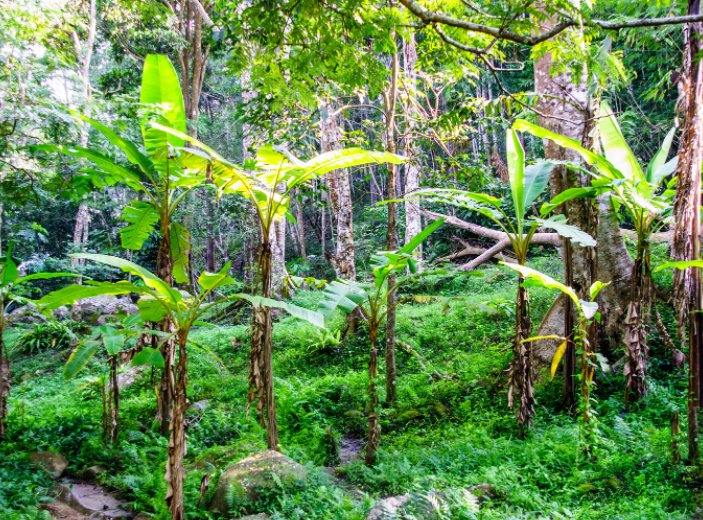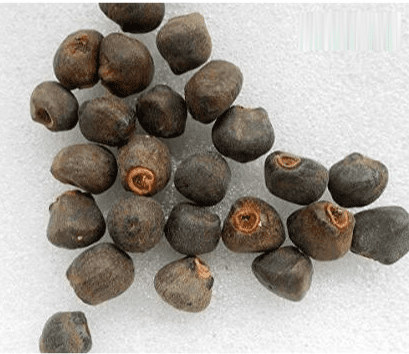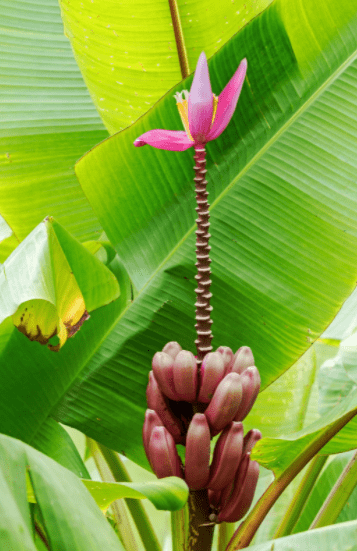
Bananas Do Have Seeds, Not All Though
What happens if banana fruits start producing seeds?
Indeed, many people ask do bananas have seeds, this would make it difficult for banana growers to sell them! A banana plant near Brindavan Extension has produced fruits having many thick seeds.
The yellow bananas that we eat have seeds, but they’re so small and not functional. However, wild banana varieties carry big seeds that would make it difficult for us to eat them. The banana we all eat is cultivated with the precise purpose of being made seedless.
Scientifically speaking, Banana Musa (Musaceae) has a fairly wide diversity with over 50 species. The name was possibly derived from the Arabic / Persian mawz / mauz or Turkish (muz) names for the fruit.
In this plant, flowers are born on a long, pendulous inflorescence, usually unisexual.
The female flowers are produced near the base of the peduncle, while the male flowers are formed on the tip of the same peduncle. The ovaries in the first female flowers multiply, developing parthenocarpically (no pollination) into clusters of fruits, called hands.
The male flowers fall off. If pollination occurs by pollinators, seeds are developed inside the fruits. The seeded and the parthenocarpic fruits are very similar in structure before they are unopened.
Seedlessness is a critical feature in some commercial fruits. Commercial cultivars of bananas and pineapples are examples of seedless fruits.
A few cultivars of citrus fruits (oranges), mandarin oranges, grapefruit, table grapes, and watermelons are valued for their seedlessness.
Have you had any idea that the average human consumes over 25 pounds of bananas per year?
Bananas are a nutritious and tasty treat that must be peeled before consumption. But have you ever given it a thought why they’re considered a fruit?
Bananas are classified as a fruit, as they contain seeds from the plant from which they grow. You may not have expected bananas as bearing seeds, but they do!
Banana seeds are minor and turn out to be almost invisible. It wasn’t always like this. Humans have had an important impact on banana development, contributing to their “new” appearance and taste.
Do Bananas Contain Seeds?
Bananas, yes, they have seeds. Contemporary commercial-grade bananas are genetically bred and are not cultivated from seeds. The seeds are visible, but they cannot contribute to the reproduction of bananas.
Wild bananas have larger, more visible seeds and may aid in growing a new banana plant if produced by the mother plant.
Why Aren’t Commercial Bananas Seeded?
Bananas indeed have seeds, but the genetic modification process used by humans has resulted in a fruit in which seeds are almost an afterthought. Large seeds are rarely found in commercial bananas. Why?
Farmers took cuttings from plants with mutations that prevented them from producing seeds, realizing that they were not required to farm bananas.
Commercially cultivated bananas have been cultivated specifically for consumption, so seeds would be avoided.
The science behind seedless bananas is based on a chromosomal imbalance. The modern banana is triploid, which means it has three chromosomes.
The banana receives one pair of chromosomes from one parent plant and two pairs of chromosomes from another parent plant, rather than a single set of chromosomes from each parent.
Bananas reproduce asexually. Parthenocarpy refers to the development of bananas without fertilization, which results in fruit without seeds.
In the aftermath, “seedless” bananas have numerous advantages. Commercial bananas, such as those found in your local grocery store, are more flavorful and sweet.
The lack of seeds or tiny seeds allows for easier consumption and a better human experience. Because of this discovery, bananas now have a more extended shelf and post-shelf life.
While few seeds can still be seen when cutting down the middle of a commercial banana, their function is mainly obsolete. At this point in its lifecycle, the primary purpose of a banana is to look aesthetically pleasing for human consumption, not to reproduce.
Is It Possible To Find Seeds In Wild Bananas?
It is difficult to find edible wild bananas. They are typically found in remote areas, such as jungles or valleys. If you come across a wild banana plant, you might be awestruck by its visual appearance.
Wild banana plants possess thick leaves that stretch uniformly upwards. In addition, the plant’s trunk is thicker and more robust than that of a commercial banana plant.
Wild bananas have larger seeds that may not be as appetizing as the bananas we are accustomed to. These bananas bear more seeds than edible bananas sometimes!
As seen you can see in the image below, wild bananas seeds are the size of peas!

On the other hand, these wild banana plants are precious because they can reproduce from their mother plant. In other words, these seeds can grow and reproduce.
Around the world, wild bananas are typically found near forest areas. Wild bananas tend to grow in unusual shapes and sizes due to the natural habitat of some of these regions. Furthermore, the peel of these bananas does not have the same glow that we are all accustomed to.
Can Banana Seeds Be Consumed?
If you come across a banana with seeds, you might wonder if the seeds are safe to eat. Yes, banana seeds can be consumed. Banana seeds are not poisonous, whether ripe or raw.
On the other hand, wild bananas are deemed almost inedible when they produce a slew of solid pea-sized seeds. Whereas wild bananas may still be safe to eat, it is difficult and not worth the risk.
Wild bananas with big seeds are typically smaller and contain more seeds compared to edible flesh.
Bananas with seeds are commonly regarded as inedible because of their difficulty in chewing and swallowing!
Another issue with eating bananas with seeds is that the seeds take up too much space inside the banana, making it difficult to eat the flesh or pulp.
Is It Safe to Eat Wild Bananas?
Is it possible to eat wild bananas? Wild bananas can be eaten. Depending on the variety and region of the wild bananas, some can be pretty tasty and contain almost no seeds at all.
It is a common misconception that all wild bananas come with seeds, but this is not true.

A popular type of wild banana can be found in Costa Rica, where they are referred to as “baby bananas.”
These bananas ripen quickly and taste fantastic! Even as a teenager, I had no doubts about nibbling on these amazing wild treats.
Baby bananas, also known as “Lady Fingers,” have a much creamier and sweeter flavor than regular bananas.
When you see baby bananas, you’ll notice their bright yellow color most of the time. Smaller dots or freckles indicate that the baby bananas are ripe and ready for consumption.
However, even if the variety is edible, you should not eat it if the plant has been influenced by pesticides, birds, or insects.
It is hardly worth the risk of consuming possibly toxic bacteria from an unknown plant. Before consuming, it is recommended to test a few bananas near the top of the plant.
Last Thoughts
Bananas contain seeds, but modern, industrially farmed bananas have been genetically bred to prevent seed development.
Commercial bananas are a common type of banana that we consume, and they are commonly the only choice available at a local grocery store.
Wild bananas have seeds, and if they are produced from the mother plant, the seeds can result in reproduction.
Banana seeds are edible, especially given the small size of the seeds found in commercial bananas. Wild bananas have substantial seeds and should not be swallowed.
The existence of seeds in wild bananas does not suggest that all wild bananas grow seeds. The banana’s kind and source can play an essential role in establishing whether humans can consume that type of banana.




























